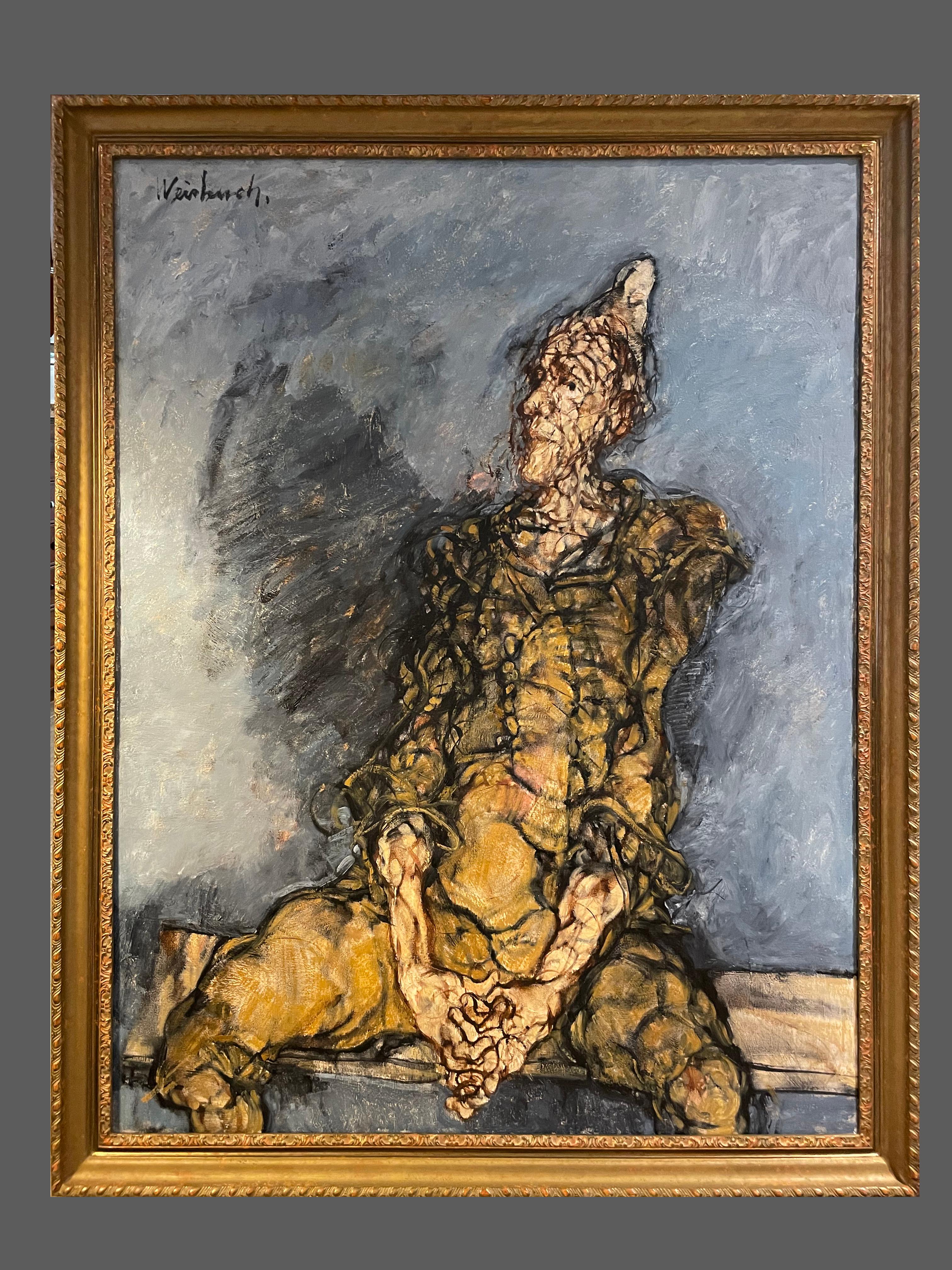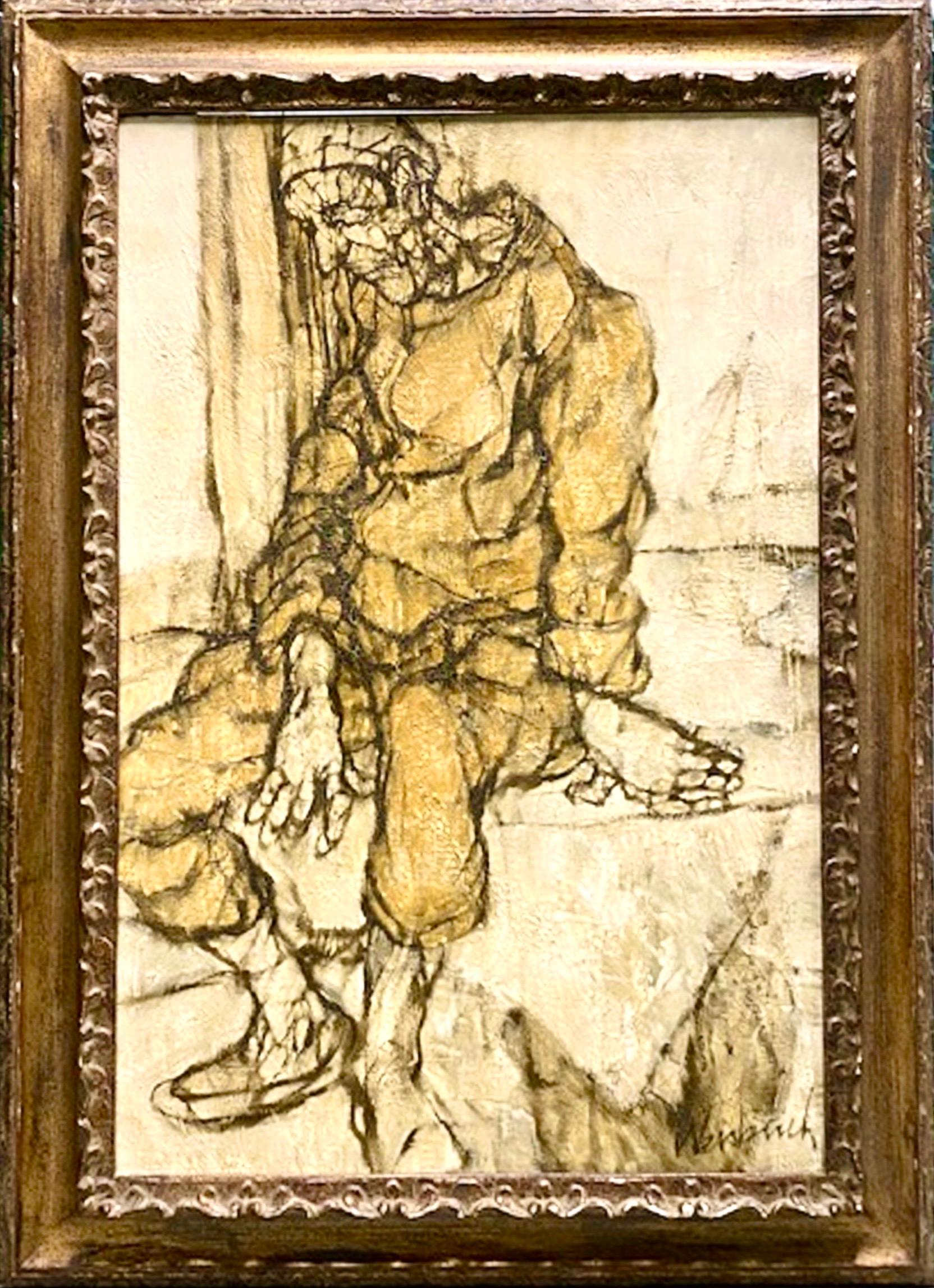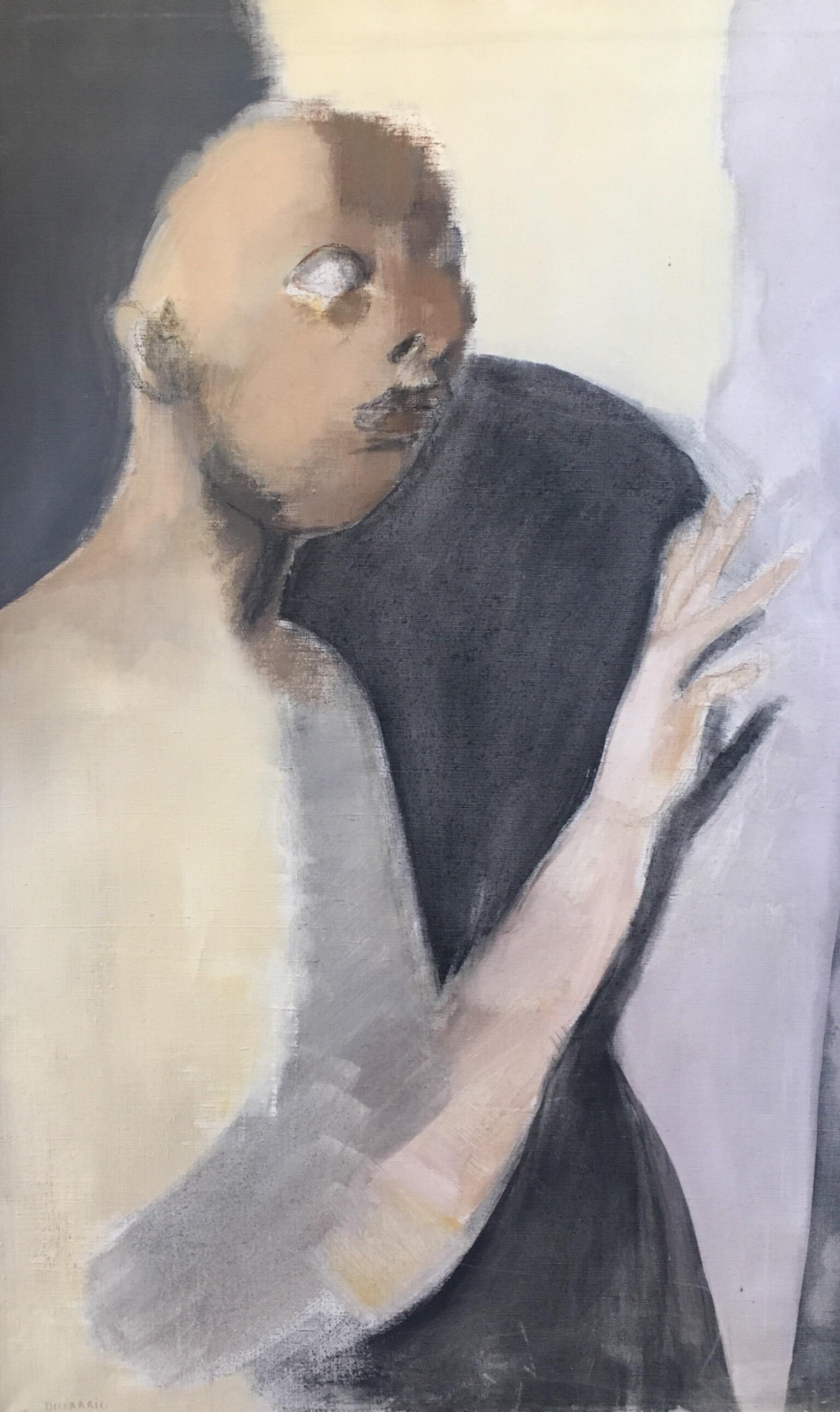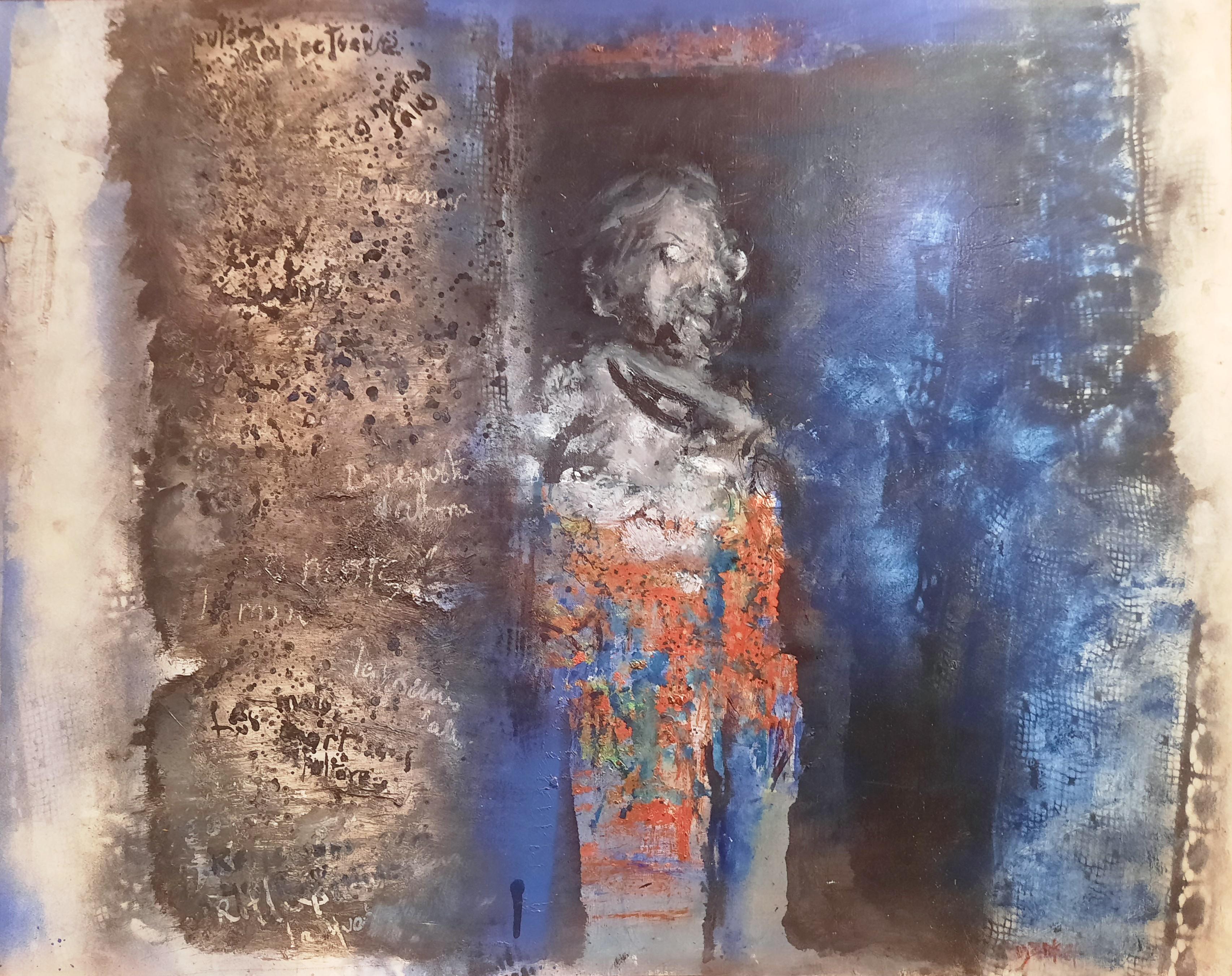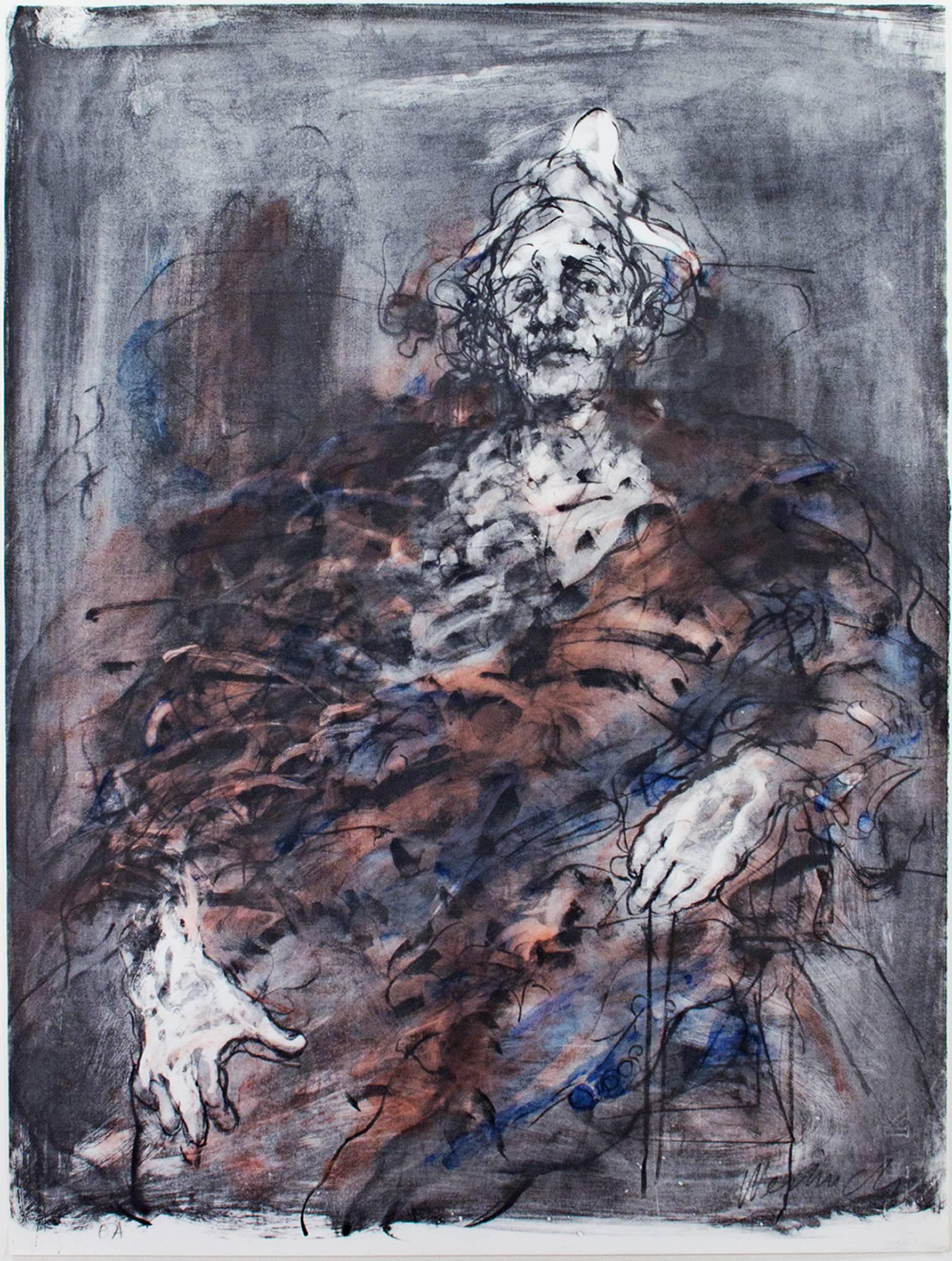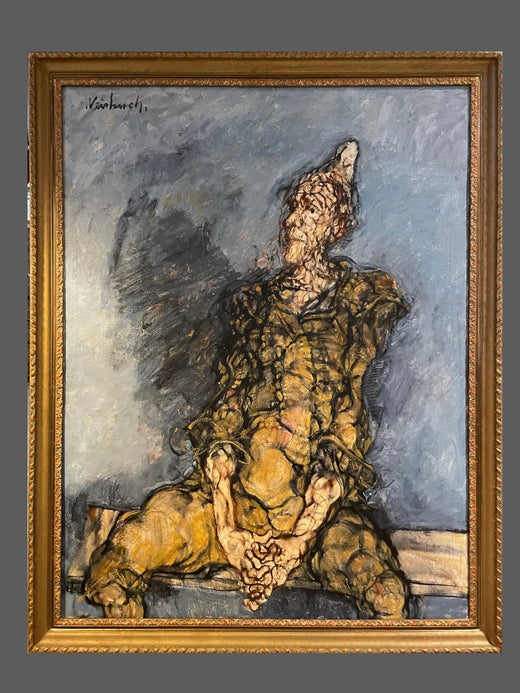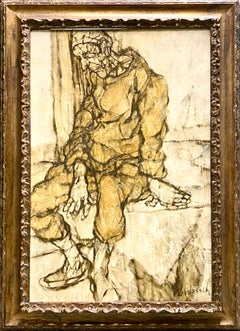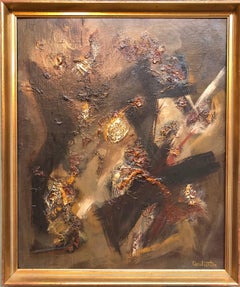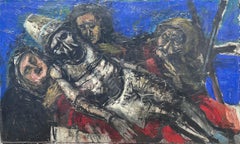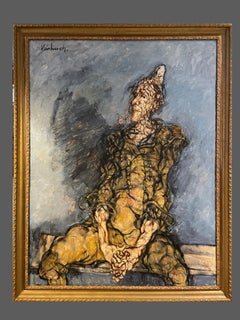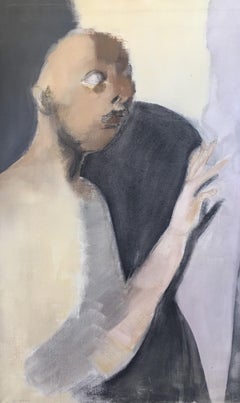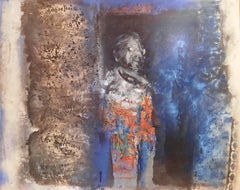Items Similar to French 1961 "Clown a la Colerette" Figurative Expressionist Oil Painting
Want more images or videos?
Request additional images or videos from the seller
1 of 9
Claude WeisbuchFrench 1961 "Clown a la Colerette" Figurative Expressionist Oil Painting1961
1961
$8,500
£6,414.72
€7,343.88
CA$11,987.82
A$13,161.13
CHF 6,866.19
MX$159,267.99
NOK 86,057.02
SEK 81,088.34
DKK 54,820.11
About the Item
WEISBUCH, Claude. Oil on Canvas "Clown a la Colerette" 1961. Signed lower right, further signed, titled and dated verso. Dimensions: 18.25" high x 24" wide.
Claude Weisbuch, 1927-2014 French painter, draftsman and engraver. He studied at the Ecole des Beaux-Arts (School of Fine Arts) in Nancy and upon graduation became a professor of engraving at the Ecole des Beaux-Arts de of St. Etienne. His first solo exhibition was in 1957.
In 1968 , he became a full member of the Society of French Painters-Engravers .
In 1997 he was awarded the Legion of Honor
His work is essentially devoted to engraving, by which he likes to translate, thanks to the line, the life, movement and character of his characters: Punchinels, harlequins, musicians or equestrian scenes. He practices various techniques ( lithography, drypoint etching etc.) that he puts to use in the illustration of bibliophile books.
Claude Weisbuch is also a painter and draftsman. His favorite colors are ochres, browns and whites, with which he seeks to introduce the effects of light by compositions where the line and finesse of the drawing preserve the life found in his engravings.
His precise and dynamic line delivers a moving and swirling work on themes he loves: theater, opera, equestrian, musicians, card players, Kabuki dancers and many portraits.
His works have the appearance of unfinished sketches mixing few colors but a great vivacity of the line. He illustrated many limited edition signed fine art books. Alon with Christo, Arman and Cesar he is considered among the great post war French artists of the last generation.
Exhibitions
1957: Saint Placide Gallery, paintings and engravings
1958: Galerie de Presbourg, Paris, paintings - Saint Placide Gallery, Paris, paintings - Galerie des Arts, Nancy, etchings
1960: Galerie Hervé, "Extraordinary Pantomimes", Paris, paintings
1961: Salon of the young painting and painters witnesses of their time
1962: O'Hanna Gallery, London , paintings
1963: Galerie Hervé, "Portrait Of Man", Paris, Paintings - Nichido Gallery, Tokyo, Paintings
1965: Hervé Gallery, "100 Drawings", Paris Dresdener Gallery, Toronto, paintings
1966: Dantesca Gallery, Turin , paintings, engravings, drawings
1968: New Vision Gallery, Paris, engravings
1969: Galerie Hervé, Paris, paintings - Galerie Reflets, Brussels , prints, paintings - Galerie Dresder, Montreal , paintings
1970: Taménaga Gallery, Tokyo, paintings - Sagot Gallery - The Garrec, Paris, etchings - Museum of Modern Art of the City of Paris ARC, Paris, prints 5
1971: War Gallery, Avignon , etchings Biennial of Engraving, Epinal
1972: Dantesca Gallery, Turin Festival, Sarlat , paintings
1973: Wayss Gallery, Nancy , paintings, engravings, drawings Auguste Comte Gallery, Lyon , paintings, engravings, drawings Taménaga Gallery, Tokyo, paintings - New Vision Gallery, "Homage to Rembrandt", Paris, etchings
1974: Esthetika Gallery, Kortrijk, engravings - Galerie Hervé Odermatt, Paris, paintings Ésthetika Gallery, Kurne, prints - Galerie Wayss, Nancy, engravings, drawings, pastels Dietesheim Gallery, Neuchâtel , engravings - Grafikhuset Gallery, Stockholm , prints, drawings
1975: Schwarzer Gallery, Vienna , engravings, paintings, drawings Fogola Gallery, Turin, drawings, pastels Sotheby-Parke Benett, Munich, engravings, drawings Hervé Odermatt Gallery, Paris, drawings Joly Gallery, Washington , engraving
1976: Taménaga Gallery, Tokyo, paintings - Wayss Gallery, Nancy, engravings, drawings - Tabula Gallery, Tübingen, engravings, drawings - New Vision Gallery, "The horse-The painter and his model", Paris, drawings, engravings
1977: Grafikhuset, Futura, Stockholm - Jivô Gallery, Vänersborg Pigalle Gallery, Norrköping Celsius Gallery, Uppsala Möbius Gallery, Gothenburg - New Vision Gallery, Jerusalem - Cultural Center of Sainte-Menehould Castle, retrospective, engravings
1978: David Barnett Gallery, Milwaukee , engravings, drawings Orangery Gallery, Cologne , engravings, drawings, pastels Grafikhuset Futura, Stockholm, paintings, drawings Les Cordeliers, Châteauroux, engravings, drawings, paintings House of Culture, Montbéliard, engravings House of Culture, Chelles , engravings, paintings, drawings
1979: L'Empreinte Gallery, Strasbourg, prints, drawings - Galerie Reflets, Brussels, prints, drawings - Galerie Bon à tirer, Los Angeles , prints, pastels
1980: Hervé Odermatt Gallery, Paris, "Calligraphy of the figure", paintings - E. Gollon Gallery, Saint-Paul-de-Vence
1981: European Biennale of Engraving, Baden-Bade Galerie The Art Shop, Nice Galerie Hélène Trintignant, Montpellier Martine Remy Gallery, Strasbourg
1982: Vallen Gallery, Stockholm - Sagot Gallery - The Garrec, Paris - Taménaga Gallery, Tokyo, paintings - New Vision Gallery, Tokyo, Nagoya, Osaka, etchings
1983: Hélène Trintignant Gallery, Montpellier
1984: Perrine Museum, Laval , etchings - Music Festival, Quimper , etchings Etchings, Moscow - Presence Gallery, Brussels, paintings, etchings
1985: Galerie Moyon-Avenard, Nantes, paintings - Taménaga Gallery, Paris, paintings - New Otani Hotel, Ōsaka, realization of murals
1986: Taménaga Gallery, Tokyo, paintings - Greenhouse of the School of Fine Arts, Saint-Étienne , paintings, engravings
1988: Retrospective paintings, Château de Chenonceau Retrospective engravings, Artothèque Museum Montpellier Taménaga Gallery, Paris, drawings, pastels New Vision Gallery, Tokyo, engravings
1989: Galerie Taménaga, Paris, paintings
Exit of the book Weisbuch , texts of Jean-Denis Bredin of the French Academy, preface by Jean-Marie Tasset.
1990: Taménaga Gallery, Paris, paintings
1992: Retrospective, Sarlat - Taménaga Gallery, Paris, drawings
1993: Taménaga Gallery, Tokyo and Osaka
1994: Paintings for the second international meetings of the cello ensemble, Beauvais - Elegance Gallery, Taipei - Sanbi Gallery, Tokyo, graphic works - Mitsukoshi, Tōkyō
1995: Taménaga Gallery, Ōsaka - Exhibition of the Gobelins Municipal Circle, Paris 13 th
1996: 2nd Music Trades Fair, Premonstratensian Abbey , Pont-à-Mousson , paintings - Ginza Spring, Tokyo, paintings - New Otani Museum, Tokyo, paintings
1997: Galerie Raugraff, Nancy, paintings, pastels, drawings, engravings, lithographs - Theater Gallery, Besançon, paintings, drawings, engravings, lithographs
1999: A retrospective "Weisbuch, 50 years of prints", 230 works exhibited in Strasbourg under the direction of its publisher, L'Estampe Éditions 3 - Taménaga Gallery, Paris, Tōkyō
2000: Retrospective Château de Vascœuil , by L'Estampe - Theater Gallery, Besançon , paintings, drawings, engravings, pastels, lithographs - Retrospective Chamber of Commerce, Strasbourg - engravings (retrospective), Jacques Brel cultural center, Thionville - engravings (retrospective ), chamber of commerce, Nancy
2001: Retrospective Orangerie of Madame Élisabeth, Versailles , paintings
2002: Taménaga Gallery "Movements", Paris
2003: L'Estampe Gallery, in partnership with the Theater Gallery - prints and paintings, Besançon
2004: Taménaga Gallery "Prometheus presenting the secret of fire to humans", Paris Crid'Art Gallery, L'Estampe Gallery, Amnéville-les-Thermes , paintings, prints, drawings, prints - Galerie des Arts, Nîmes , paintings
2010: Galerie125, Argancy , recent works, exhibition of 100 recent works by the artist.
2012: Exhibition at the Château de Malbrouck . More than 150 works by the artist. Organized by the General Council of Moselle and L'Estampe (editor Claude Weisbuch).
2012: Print, Strasbourg, paintings, engravings, drawings
2012: Exhibition at the House of wines of Graves de Podensac in Gironde. 150 works by the artist Event organized by Course N ° 3.
2013: Galerie125, Argancy, "Weisbuch, major works", exhibition of drawings, engravings, lithographs and oils on canvas
2014: Galerie125, Argancy, "Weisbuch, from 1947 to 1960", exhibition of 100 ancient engravings
2014: The Print, Strasbourg, "The homage to Weisbuch"
2015: Galerie125, Argancy and Galerie Guy Pensa, Algrange "Claude Weisbuch"
Musee cantonal des Beaux-Arts - Lausanne
Museo provincial de Bellas Artes - Cordoba
Muzej Savremene Umenosti - Belgrade
Bibliotheque nationale - Paris
Centre national d'art contemporain - Paris
Muzeum Sztoki w Lodzi - Lodz
The Art Gallery of South Australia - Adelaide
Muzeum Nardowe - Varsovie
Musee d'art moderne de la Ville de Paris
Muzeum Nardowe - Cracovie
Muzej na Sovremena Umetnost - Skopje
The Museum of Modern Art - New York
Musee national d'art moderne - Paris
Centre Georges-Pompidou - Paris
Stedelijk Museum - Amsterdam
Staatliche Graphische Sammlung - Munich
Staatsgalerie - Stuttgart
Goteborgs Kunstmusseum - Goteborg
Musee de Rennes
Cabinet des Estampes - Strasbourg
Musee de Mulhouse
Academie royale - Bruxelles
- Creator:Claude Weisbuch (1927, French)
- Creation Year:1961
- Dimensions:Height: 20.75 in (52.71 cm)Width: 26.75 in (67.95 cm)
- Medium:
- Movement & Style:
- Period:
- Condition:
- Gallery Location:Surfside, FL
- Reference Number:1stDibs: LU38212687872
Claude Weisbuch
Claude Weisbuch was born in Thionville, France in 1927 and was a pupil at L' École des Beaux-Arts de Nancy, France. As a painter, engraver, and exceptional lithographer, Claude Weisbuch has painted active motifs, such as musicians, horses, and characters. Dominating in his work, by the relief and the velvety line which characterizes drypoint, his etchings are the strongest representations of his figures, intensely lively after the 1960s. Using dark tones which express his sharp sense, Claude Weisbuch ceaselessly captures life's dynamics, as the pictorial, musical and literary expressions that are essentially human. Whether it is the impassioned violinist, the mercurial actor, or the sitter shrouded with silent intensity, they have all been rendered with Weisbuch's love for drama. The brushstrokes are sweeping and bold while the paint is fluid. His pictures, full of movement, give one the impression of time-lapsed motion and display an expression of passionate humanity tinged with a unique energy. Weisbuch has been quoted as saying “I like the sketch, the uncompleted, the painting filled with mystery,”. "Some important things to look for in evaluating an artist for such a position of honour are: an inventiveness of style, a prolific output, and a consistency of quality--Claude Weisbuch has all three. His style is unique with a color range that is rich and warm in tone, certainly equal to that of Rembrandt. The fluidity of line and creation of motion is even more vigorous than in the work of Daumier or Toulouse Lautrec. His creativeness in composition is awesome and seems to have infinite possibilities of variation and vision." - David Barnett
About the Seller
4.9
Platinum Seller
Premium sellers with a 4.7+ rating and 24-hour response times
Established in 1995
1stDibs seller since 2014
1,810 sales on 1stDibs
Typical response time: 1 hour
- ShippingRetrieving quote...Shipping from: Surfside, FL
- Return Policy
Authenticity Guarantee
In the unlikely event there’s an issue with an item’s authenticity, contact us within 1 year for a full refund. DetailsMoney-Back Guarantee
If your item is not as described, is damaged in transit, or does not arrive, contact us within 7 days for a full refund. Details24-Hour Cancellation
You have a 24-hour grace period in which to reconsider your purchase, with no questions asked.Vetted Professional Sellers
Our world-class sellers must adhere to strict standards for service and quality, maintaining the integrity of our listings.Price-Match Guarantee
If you find that a seller listed the same item for a lower price elsewhere, we’ll match it.Trusted Global Delivery
Our best-in-class carrier network provides specialized shipping options worldwide, including custom delivery.More From This Seller
View AllLarge French Figurative Expressionist Oil Painting Seated Figure Claude Weisbuch
By Claude Weisbuch
Located in Surfside, FL
WEISBUCH, Claude.
Oil on Canvas
Framed size: 39” H x 28” W
Canvas, without frame: 32” high x 21 ¼” wide.
Carved wooden frame with antique gold-leaf finish
Claude Weisbuch, 1927-2014 French painter, draftsman and engraver. He studied at the Ecole des Beaux-Arts (School of Fine Arts) in Nancy and upon graduation became a professor of engraving at the Ecole des Beaux-Arts de of St. Etienne. His first solo exhibition was in 1957.
In 1968 , he became a full member of the Society of French Painters-Engravers .
In 1997 he was awarded the Legion of Honor
His work is essentially devoted to engraving, by which he likes to translate, thanks to the line, the life, movement and character of his characters: Punchinels, harlequins, musicians or equestrian scenes. He practices various techniques ( lithography, drypoint etching etc.) that he puts to use in the illustration of bibliophile books.
Claude Weisbuch is also a painter and draftsman. His favorite colors are ochres, browns and whites, with which he seeks to introduce the effects of light by compositions where the line and finesse of the drawing preserve the life found in his engravings.
His precise and dynamic line delivers a moving and swirling work on themes he loves: theater, opera, equestrian, musicians, card players, Kabuki dancers and many portraits.
His works have the appearance of unfinished sketches mixing few colors but a great vivacity of the line. He illustrated many limited edition signed fine art books. Alon with Christo, Arman and Cesar he is considered among the great post war French artists of the last generation.
Exhibitions
1957: Saint Placide Gallery, paintings and engravings
1958: Galerie de Presbourg, Paris, paintings - Saint Placide Gallery, Paris, paintings - Galerie des Arts, Nancy, etchings
1960: Galerie Hervé, "Extraordinary Pantomimes", Paris, paintings
1961: Salon of the young painting and painters witnesses of their time
1962: O'Hanna Gallery, London , paintings
1963: Galerie Hervé, "Portrait Of Man", Paris, Paintings - Nichido Gallery, Tokyo, Paintings
1965: Hervé Gallery, "100 Drawings", Paris Dresdener Gallery, Toronto, paintings
1966: Dantesca Gallery, Turin , paintings, engravings, drawings
1968: New Vision Gallery, Paris, engravings
1969: Galerie Hervé, Paris, paintings - Galerie Reflets, Brussels , prints, paintings - Galerie Dresder, Montreal , paintings
1970: Taménaga Gallery, Tokyo, paintings - Sagot Gallery - The Garrec, Paris, etchings - Museum of Modern Art of the City of Paris ARC, Paris, prints 5
1971: War Gallery, Avignon , etchings Biennial of Engraving, Epinal
1972: Dantesca Gallery, Turin Festival, Sarlat , paintings
1973: Wayss Gallery, Nancy , paintings, engravings, drawings Auguste Comte Gallery, Lyon , paintings, engravings, drawings Taménaga Gallery, Tokyo, paintings - New Vision Gallery, "Homage to Rembrandt", Paris, etchings
1974: Esthetika Gallery, Kortrijk, engravings - Galerie Hervé Odermatt, Paris, paintings Ésthetika Gallery, Kurne, prints - Galerie Wayss, Nancy, engravings, drawings, pastels Dietesheim Gallery, Neuchâtel , engravings - Grafikhuset Gallery, Stockholm , prints, drawings
1975: Schwarzer Gallery, Vienna , engravings, paintings, drawings Fogola Gallery, Turin, drawings, pastels Sotheby-Parke Benett, Munich, engravings, drawings Hervé Odermatt Gallery, Paris, drawings Joly Gallery, Washington , engraving
1976: Taménaga Gallery, Tokyo, paintings - Wayss Gallery, Nancy, engravings, drawings - Tabula Gallery, Tübingen, engravings, drawings - New Vision Gallery, "The horse-The painter and his model", Paris, drawings, engravings
1977: Grafikhuset, Futura, Stockholm - Jivô Gallery, Vänersborg Pigalle Gallery, Norrköping Celsius Gallery, Uppsala Möbius Gallery, Gothenburg - New Vision Gallery, Jerusalem - Cultural Center of Sainte-Menehould Castle, retrospective, engravings
1978: David Barnett Gallery, Milwaukee , engravings, drawings Orangery Gallery, Cologne , engravings, drawings, pastels Grafikhuset Futura, Stockholm, paintings, drawings Les Cordeliers, Châteauroux, engravings, drawings, paintings House of Culture, Montbéliard, engravings House of Culture, Chelles , engravings, paintings, drawings
1979: L'Empreinte Gallery, Strasbourg, prints, drawings - Galerie Reflets, Brussels, prints, drawings - Galerie Bon à tirer, Los Angeles , prints, pastels
1980: Hervé Odermatt Gallery, Paris, "Calligraphy of the figure", paintings - E. Gollon Gallery, Saint-Paul-de-Vence
1981: European Biennale of Engraving, Baden-Bade Galerie The Art Shop, Nice Galerie Hélène Trintignant, Montpellier Martine Remy Gallery, Strasbourg
1982: Vallen Gallery, Stockholm - Sagot Gallery - The Garrec, Paris - Taménaga Gallery, Tokyo, paintings - New Vision Gallery, Tokyo, Nagoya, Osaka, etchings
1983: Hélène Trintignant Gallery, Montpellier
1984: Perrine Museum, Laval , etchings - Music Festival, Quimper , etchings Etchings, Moscow - Presence Gallery, Brussels, paintings, etchings
1985: Galerie Moyon-Avenard, Nantes, paintings - Taménaga Gallery, Paris, paintings - New Otani Hotel, Ōsaka, realization of murals
1986: Taménaga Gallery, Tokyo, paintings - Greenhouse of the School of Fine Arts, Saint-Étienne , paintings, engravings
1988: Retrospective paintings, Château de Chenonceau Retrospective engravings, Artothèque Museum Montpellier Taménaga Gallery, Paris, drawings, pastels New Vision Gallery, Tokyo, engravings
1989: Galerie Taménaga, Paris, paintings
Exit of the book Weisbuch , texts of Jean-Denis Bredin of the French Academy, preface by Jean-Marie Tasset.
1990: Taménaga Gallery, Paris, paintings
1992: Retrospective, Sarlat - Taménaga Gallery, Paris, drawings
1993: Taménaga Gallery, Tokyo and Osaka
1994: Paintings for the second international meetings of the cello ensemble, Beauvais - Elegance Gallery, Taipei - Sanbi Gallery, Tokyo, graphic works - Mitsukoshi, Tōkyō
1995: Taménaga Gallery, Ōsaka - Exhibition of the Gobelins Municipal Circle, Paris 13 th
1996: 2nd Music Trades Fair, Premonstratensian Abbey , Pont-à-Mousson , paintings - Ginza Spring, Tokyo, paintings - New Otani Museum, Tokyo, paintings
1997: Galerie Raugraff, Nancy, paintings, pastels, drawings, engravings, lithographs - Theater Gallery, Besançon, paintings, drawings, engravings, lithographs
1999: A retrospective "Weisbuch, 50 years of prints", 230 works exhibited in Strasbourg under the direction of its publisher, L'Estampe Éditions 3 - Taménaga Gallery, Paris, Tōkyō
2000: Retrospective Château de Vascœuil , by L'Estampe - Theater Gallery, Besançon , paintings, drawings, engravings, pastels, lithographs - Retrospective Chamber of Commerce, Strasbourg - engravings (retrospective), Jacques Brel cultural center, Thionville - engravings (retrospective ), chamber of commerce, Nancy
2001: Retrospective Orangerie of Madame Élisabeth, Versailles , paintings
2002: Taménaga Gallery "Movements", Paris
2003: L'Estampe Gallery, in partnership with the Theater Gallery - prints and paintings, Besançon
2004: Taménaga Gallery "Prometheus presenting the secret of fire to humans", Paris Crid'Art Gallery, L'Estampe Gallery, Amnéville-les-Thermes , paintings, prints, drawings, prints - Galerie des Arts, Nîmes , paintings
2010: Galerie125, Argancy , recent works, exhibition of 100 recent works by the artist.
2012: Exhibition at the Château de Malbrouck . More than 150 works by the artist. Organized by the General Council of Moselle and L'Estampe (editor Claude Weisbuch).
2012: Print, Strasbourg, paintings, engravings, drawings
2012: Exhibition at the House of wines of Graves de Podensac in Gironde. 150 works by the artist Event organized by Course N ° 3.
2013: Galerie125, Argancy, "Weisbuch, major works", exhibition of drawings, engravings, lithographs and oils on canvas
2014: Galerie125, Argancy, "Weisbuch, from 1947 to 1960", exhibition of 100 ancient engravings...
Category
20th Century Modern Figurative Paintings
Materials
Canvas, Oil
French Gestural Abstract Expressionist Textured Oil Painting
By Rene Couturier
Located in Surfside, FL
Rene Couturier lives in the Netherlands and France. Rene Couturier is known for abstract still life, figure and landscape painting.
Rene' Couturier is an artist whose works displays...
Category
1970s Abstract Expressionist Abstract Paintings
Materials
Canvas, Oil
Portrait of a Gentleman, Large Modernist Oil Painting
By Benjamin Kopman
Located in Surfside, FL
BENJAMIN KOPMAN (1887 - 1965)
Painter, Illustrator and printmaker Benjamin Kopman was born in Vitebsk, Russia and emigrated to the United States with his family in 1903. It was a cen...
Category
Mid-20th Century Expressionist Portrait Paintings
Materials
Canvas, Oil
Large Figurative Expressionist Oil Painting Rediscovered New York City Artist
By Jonah Kinigstein
Located in Surfside, FL
Jonah Kinigstein (b. 1923) is an American Postwar & Contemporary painter. He works in a figurative expressionist style. His works are featured in the Smithsonian American Art Museum,...
Category
20th Century Expressionist Portrait Paintings
Materials
Oil, Board
Rare Israeli Modernist Oil Painting Exhibited 1951 Tel Aviv Museum
By Anatol Gurevitch
Located in Surfside, FL
Gurevich Anatole Anatol Gurevitch Anatol Gurewitsch (1916-2005)
Per the hebrew label on the back, this was exhibited in 1951. I believe at the Tel Aviv museum of art (as per the Israel Museum (Jerusalem) website)m in a manner reminescent of Bezalel Schatz, Moshe Castel, Jean david and other Israeli artists of the New Horizons prominent in that period ts a nude crouching figure against a colorful abstract background.
Israeli Painter and stage designer. Yakir of Tel Aviv. Born in Russia, Moscow in the mid-teens of the twentieth century. Studied painting in Berlin. Immigrated to Palestine from Germany in 1934. Served in the British Army (1941-1946). Known for his pantings of Jewish rabbis and other Judaica subject matter. He specialized in stage design for dance troupes: the dance troupe led by Gertrude Kraus, Inbal, the Batsheva Dance Company, the international black dancer tali bati. His first wife was the late dancer and choreographer - the girl Kesten, His son is theater director Michael Gurevich. His second wife was the actress - Rivka Gur, who gave birth to his second son, Eyal. He died at the age of 89 after a serious illness. He left behind two sons: Michael (Miki) Gurevitch and Eyal Gurevitch. He was the uncle of the artist and sculptor - Igael Tumarkin.
He was a stage designer in the theaters
The brothel of Hunzo from Kibbutz Givat Haim, the British military band of this type, the British army, Gertrud Kraus, the Inbal Dance Theater, the Israeli Ballet, the Batsheva Dance Company and more.
He designed a stage for plays
The girl and the Negro, the Threepenny Opera, a band on the Thames, the singer of the land (in the military band of 1944), the banknote to Shlomo, the tea department, Nathan the Wise, Herod and Miriam.
Awards
Yakir Tel Aviv Prize, on behalf of the Tel Aviv Municipality.
Anatol Gurewitsch, painter and Stage designer, born 1916, Moscow. After Second World War worked as stage designer. Designed costumes for dancer Gertrud Krausz. Uncle of Igael Tumarkin, and father of the theater Director Miki Gurewitsch.
Education
Academy of Fine Arts, Berlin, art
1936 with Frenel Frankel
1937 with Miron...
Category
1940s Modern Figurative Paintings
Materials
Oil, Board
Clown, Modernist Oil Painting on Board WPA Artist
By Maurice Kish
Located in Surfside, FL
This portrait of a clown by Maurice Kish is part from a series of carnival figures, circus clowns and carousel horses and riders that he did in the 30s and 40s. The artist uses a vib...
Category
Early 20th Century Modern Portrait Paintings
Materials
Oil, Board
You May Also Like
The Clown
By Claude Weisbuch
Located in West Palm Beach, FL
The Clown by Claude Weisbuch, is 50 X 40 framed. The canvas is 46 X 35.
This painting has been in a family collection since the 1960's.
This esteemed artist...
Category
1960s Abstract Expressionist Figurative Paintings
Materials
Canvas, Oil
Huge French Modernist Figurative Portrait, Original Oil Painting Signed
By Élisabeth Dujarric de La Rivière
Located in Cirencester, Gloucestershire
Lost, Abstract Portrait, Original Oil Painting, Signed
By French artist Elisabeth Dujarric, b.1930-2005
Signed by the artist on the lower left hand corner
Oil painting on canvas, framed
Canvas size: 60 x 38 inches
Elisabeth Dujarric de la Rivière...
Category
1970s Abstract Abstract Paintings
Materials
Oil
Clown, 1998 - oil paint, 75x60 cm, framed
By Armand Avril
Located in Nice, FR
Gouache on paper, signed on the leg of the clown.
Armand Avril, né à Lyon en 1926, est un peintre vivant à Cotignac dans le Var. Il est surtout connu pour les assemblages qu'il a réalisés à partir de 1968. D'origine modeste, cependant très tôt intéressé par l'art et les musées où le poussait son père, il s'essaie d'abord à la peinture. Cependant, Avril ne commence à trouver son véritable style qu'à l'âge de quarante-deux ans.
Enfant, il est un habitué des musées de Lyon qu’il fréquente sur les conseils de son père. Adulte, sa passion pour la collection l’incite à se nourrir des arts premiers et d’artistes comme Gaston Chaissac...
Category
1990s Expressionist Abstract Drawings and Watercolors
Materials
Oil
Portrait of Jean-Paul Sartre Yankel Contemporary painting portrait art oil paint
By Jacques Yankel
Located in Paris, FR
Oil painting on canvas
Unique work
Hand-signed lower right by the artist
Category
1980s Contemporary Figurative Paintings
Materials
Canvas, Oil
"Le Clown, Artist's Proof, " Original Color Lithograph signed by Claude Weisbuch
By Claude Weisbuch
Located in Milwaukee, WI
"Le Clown" is an original lithograph by Claude Weisbuch. The artist signed the piece lower right and wrote the edition number (E.A.) in the lower left. This piece is a portrait of a ...
Category
1960s Modern Figurative Prints
Materials
Lithograph
European Artist. Oil on board. Portrait of a clown. Dated 1962
Located in København, Copenhagen
European Artist.
Oil on board.
Portrait of a clown.
Expressionist style with impasto strokes. Colouristic palette.
Dated 1962 on the back.
Indistinctly signed.
In perfect condition.
...
Category
Vintage 1960s Unknown Modern Paintings
Materials
Other
